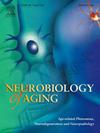Aging of gray matter microstructure: A brain-wide characterization of, age group differences using NODDI
IF 3.7
3区 医学
Q2 GERIATRICS & GERONTOLOGY
引用次数: 0
Abstract
This study aimed to provide a complete characterization of age group differences in cortical lobar, hippocampal, and subcortical gray matter microstructure using a multi-compartment diffusion-weighted MRI (DWI) approach with parameters optimized for gray matter (Neurite Orientation Dispersion and Density Imaging, NODDI). 76 younger (undergraduate students) and 64 older (surrounding communities) adults underwent diffusion-, T1-, and susceptibility-weighted MRI. Results revealed eight unique patterns across the 12 regions of interest in the relative direction and magnitude of age effects across NODDI metrics, which were grouped into three prominent patterns: cortical gray matter had predominantly higher free diffusion in older than younger adults, the hippocampus and amygdala had predominantly higher dispersion of diffusion and intracellular diffusion in older than younger adults, and the putamen and globus pallidus had lower dispersion of diffusion in older than younger adults. Results remained largely unchanged after controlling for normalized regional volume, suggesting that higher free diffusion in older than younger adults in cortical gray matter was not driven by macrostructural atrophy. Results also remained largely unchanged after controlling for iron content (QSM, R2*), even in iron-rich subcortical regions. Taken together, these patterns of age effects across NODDI metrics provide evidence of region-specific neurobiological substrates of aging of gray matter microstructure.
求助全文
约1分钟内获得全文
求助全文
来源期刊

Neurobiology of Aging
医学-老年医学
CiteScore
8.40
自引率
2.40%
发文量
225
审稿时长
67 days
期刊介绍:
Neurobiology of Aging publishes the results of studies in behavior, biochemistry, cell biology, endocrinology, molecular biology, morphology, neurology, neuropathology, pharmacology, physiology and protein chemistry in which the primary emphasis involves mechanisms of nervous system changes with age or diseases associated with age. Reviews and primary research articles are included, occasionally accompanied by open peer commentary. Letters to the Editor and brief communications are also acceptable. Brief reports of highly time-sensitive material are usually treated as rapid communications in which case editorial review is completed within six weeks and publication scheduled for the next available issue.
 求助内容:
求助内容: 应助结果提醒方式:
应助结果提醒方式:


